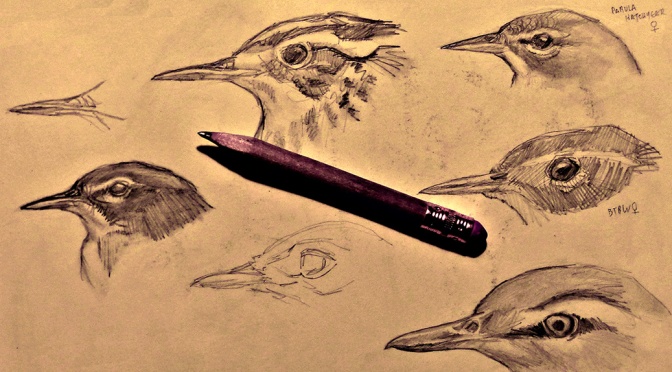“How do I get started with sketching birds in the field?”
While one could get into tedious preparations by buying materials and equipment before making the first marks, all one really needs is a regular old pencil and a pad to get started with field sketching.
But before you get started, you may want to consider the following points:
- Don’t forget the importance of observation!
- Practice, Practice Practice!
- Have lofty goals, but realistic expectations.
- Start simple.
Below I will delve more into each of these points. These apply when our goal is to depict birds and other wildlife with some degree of accuracy from observation. If you are only interested in copying images or stylizations based on imagination, then worry not about these points:
- Don’t forget the importance of observation!
- If you are struggling with drawing the shape of a shorebird, you should remember that the answer to your frustrations is in the shorebird itself. A fair dose of “observation” will give you the necessary information to draw the parts of the bird with more accuracy.
- If you are spending too much time drawing, and not enough time observing, chances are that you are making things up. You will likely never achieve the degree of desired accuracy in your renderings if you don’t spend plenty of time observing your subject.
- TRY THIS: Spend no more than 10 seconds sketching after 5 seconds of observation – and so on… Ideally, you want to spend as much time observing as you do sketching.
- Practice, practice, practice!
- While it may be relatively easy to pick up a pencil and draw a pleasant stylization of a bird, it takes plenty of practice to draw what we see in the field. Practice goes a long way!
- Warm up! In the same way we warm-up before exercising, do gesture drawings to loosen up your arms and hone in your observation skills before committing to longer renderings.
- TRY THIS: Don’t get too caught up in any one drawing, but do as many quick sketches as possible, aiming to capture different aspects of the bird in each.

- Have lofty goals, but realistic expectations.
- Your goal may be to create epic paintings with multiple birds and habitat – but remember that it takes time and commitment to grow in this craft.
- You will also discover that each small step leads to greater accomplishments. Stick to it and you will get far.
- If you are just beginning, learn to take your work lightly at first. Laugh at mistakes – and make plenty because that is how we learn.
- TRY THIS: Make several sketches from observation, without using an eraser* to correct mistakes. Instead, redraw your lines until you find the right shapes.
* Erasers are great tools, but they have their place and time. Don’t get too caught up erasing mistakes.
- Start simple.
- To get started, all you really need is a pencil and a pad.
- See if you can first “capture the gestures” of birds, before getting into any kind of detail.
- Before setting out on epic sketching expeditions to your nearby preserve, practice on common birds in your backyard – practice gestures on your pet, on people, on inanimate objects, etc.
- TRY THIS: Keep a small pad handy at all times. Do quick gestures while stuck in a waiting room or when taking a break at work. Remember – these are just practice gestures, so it does not matter how “nice” they look. Move on!
After you have considered these points, you may realize there is much more to this field sketching business. I am a strong proponent of sketching wildlife through the use of binoculars or a spotting scope – when advantageous. However, if you live near a natural site where birds are accustomed to human proximity, you may not need these tools. A simple and excellent opportunity may be practicing with feeder birds at your backyard.
You may also find the following links useful:


Rafael,
Absolutely delighted to find your site , your drawings and paintings are fantastic and the information contain here has helped greatly,
Thank you very much and much success to you in the future
Mark
Thank you Mark.